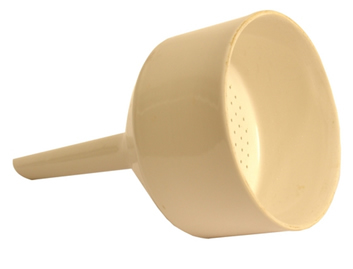Filtration is a physical method of separating heterogeneous mixtures when we have a solid dispersed in a liquid or gas. Basically, the heterogeneous mixture is passed through a filter, that is, a porous material, in which the suspended solid particles are retained, the liquid or gaseous part passes through the filter.
There are two types of filtrations, see how each is done in the laboratory and how they are used in everyday life and in industries:
- Common filtration:
use one filter paper conveniently folded in four, forming a cone, as in the image below:

The filter paper is placed in an ordinary type filter funnel, then, with the help of a glass stick, the heterogeneous mixture is poured into the funnel. Only particles that were not dissolved in the liquid part are retained on the filter paper.

This liquid can be made up of more than one substance, but if the dissolved particles are very small, forming a true solution, whose dispersed particles have a diameter smaller than 1 nm (10-9 m), or colloidal solutions, which have particles suspended between 1 and 1000 nm, so they will not be retained by the filter. Only with chemical techniques will it be possible to separate these types of mixtures.
A very common example of filtration performed in everyday life is when we prepare coffee. The strainer retains solid coffee particles and extracts soluble substances in the coffee powder.
Two other examples are:
- The water filter used at home;
- In water and sewage treatment plants, the water passes through sand filters and grates that prevent the passage of fish, plants and debris.
In addition, common filtration is also carried out in daily life in cases of mixtures between solids and gases. See some examples:

- Vacuum filtration: When a filtration takes too long, the vacuum filtration, also called reduced pressure filtration, which speeds up the process.
In the laboratory, this type of filtration is performed using a Buchner's funnel made of porcelain that has a perforated bottom.

The filter paper is placed unfolded in the Buchner funnel, which is placed on a kitassate. The kitasat, in turn, is coupled by a hose to a waterspout, which drags some of the air from the bottom of the kitasato, creating a region of low pressure inside it. Thus, when we pass the mixture through the Buchner funnel, it is subjected to suction, due to the pressure difference. As a result, filtration takes place quickly.

By Jennifer Fogaça
Graduated in Chemistry
Source: Brazil School - https://brasilescola.uol.com.br/quimica/filtracaometodo-separacao-misturas.htm



